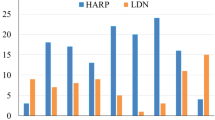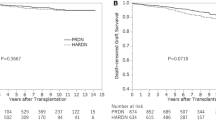Abstract
Purpose
We aim to study the preoperative and intraoperative factors and compare against specific outcomes in patients undergoing transperitoneal laparoscopic donor nephrectomy and see if we could find what were the predictive factors for these outcomes.
Methods
This is a prospective cohort study done in a single high-volume transplant center. 153 kidney donors were evaluated over a period of 1 year. The preoperative factors such as age, gender, smoking status, obesity, visceral obesity, perinephric fat thickness, number of vessels, anatomic abnormalities, comorbidities, and side of kidney and intraoperative factors such as lay of colon on the kidney, height of splenic or hepatic flexure of colon, loaded or unloaded colon, and sticky mesenteric fat were compared against specific outcomes such as duration of surgery, duration of hospital stay, postoperative paralytic ileus, and postoperative wound complications.
Results
Multivariate logistic regression models were used to study the variables of interest against the various outcomes. There were three positive risk factors for increased hospital stay, which were perinephric fat thickness and height of splenic or hepatic flexure of colon and smoking history. There was one positive risk factor for postoperative paralytic ileus which is lay of colon with relation to kidney and there was one positive risk factor for postoperative wound complication which was visceral fat area.
Conclusion
The predictive factors for adverse postoperative outcomes after transperitoneal laparoscopic donor nephrectomy were perinephric fat thickness, height of splenic or hepatic flexure, smoking status, lay or redundancy of colon with relation to kidney and visceral fat area.
Similar content being viewed by others
Data availability
The data that support the findings of the study are available upon request to the corresponding author directly. Access to the data is subject to institutional policy.
References
Axelrod DA, Schnitzler MA, Xiao H, Irish W, Tuttle-Newhall E, Chang SH et al (2018) An economic assessment of contemporary kidney transplant practice. Am J Transpl 18(5):1168–1176
Yohanna S, Naylor KL, McArthur E, Lam NN, Austin PC, Habbous S et al (2020) A propensity score-weighted comparison of outcomes between living and standard criteria deceased donor kidney transplant recipients. Transplantation 104(11):e317–e327
Englum BR, Schechter MA, Irish WD, Ravindra KV, Vikraman DS, Sanoff SL et al (2015) Outcomes in kidney transplant recipients from older living donors. Transplantation 99(2):309–315
EAU Guidelines on Renal Transplantation - THE GUIDELINE - Uroweb [Internet]. Uroweb-European Association of Urology. [cited 2023 Apr 13]. Available from: https://uroweb.org/guidelines/renal-transplantation/chapter/the-guideline
Garcia-Ochoa C, Feldman LS, Nguan C, Monroy-Cuadros M, Arnold J, Boudville N et al (2019) Perioperative complications during living donor nephrectomy: results from a multicenter cohort study. Can J Kidney Health Dis 6:2054358119857718
Shroff S (2016) Current trends in kidney transplantation in India. Indian J Urol 32(3):173–174
Lentine KL, Lam NN, Segev DL (2019) Risks of living kidney donation: current state of knowledge on outcomes important to donors. Clin J Am Soc Nephrol 14(4):597–608
Franquet Q, Matillon X, Terrier N, Rambeaud JJ, Crouzet S, Long JA et al (2021) The mayo adhesive probability score can help predict intra- and postoperative complications in patients undergoing laparoscopic donor nephrectomy. World J Urol 39(7):2775–2781
Özçelik Ü, Eren E, Urut DU, Talih T, Tokaç M, Dinçkan A (2021) Correlation between the mayo adhesive probability score and the operative time in laparoscopic donor nephrectomy. Transplant Proc 53(3):793–798
Heimbach JK, Taler SJ, Prieto M, Cosio FG, Textor SC, Kudva YC et al (2005) Obesity in living kidney donors: clinical characteristics and outcomes in the era of laparoscopic donor nephrectomy. Am J Transplant 5(5):1057–1064
Narita S, Kumazawa T, Tsuchiya N, Mingguo H, Saito M, Inoue T et al (2017) Host-related risk factors for adherent perinephric fat in healthy individuals undergoing laparoscopic living-donor nephrectomy. Surg Laparosc Endosc Percutan Tech 27(4):e69-73
Lim J, Kong YG, Kim YK, Hong B (2017) Risk factors associated with decreased renal function after hand-assisted laparoscopic donor nephrectomy: a multivariate analysis of a single surgeon experience. Int J Med Sci 14(2):159–166
von Elm E, Altman DG, Egger M, Pocock SJ, Gøtzsche PC, Vandenbroucke JP et al (2014) The Strengthening the reporting of observational studies in epidemiology (strobe) statement: guidelines for reporting observational studies. Int J Surg 12(12):1495–1499
Clavien PA, Barkun J, de Oliveira ML, Vauthey JN, Dindo D, Schulick RD et al (2009) The clavien-dindo classification of surgical complications: five-year experience. Ann Surg 250(2):187–196
Assel M, Sjoberg D, Elders A, Wang X, Huo D, Botchway A et al (2019) Guidelines for reporting of statistics for clinical research in urology. Eur Urol 75(3):358–367
Lafranca JA, Hagen SM, Dols LFC, Arends LR, Weimar W, Ijzermans JNM et al (2013) Systematic review and meta-analysis of the relation between body mass index and short-term donor outcome of laparoscopic donor nephrectomy. Kidney Int 83(5):931–939
Etchison WC, Bloodgood EA, Minton CP, Thompson NJ, Collins MA, Hunter SC et al (2011) Body mass index and percentage of body fat as indicators for obesity in an adolescent athletic population. Sports Health 3(3):249–252
Deurenberg-Yap M, Chew SK, Deurenberg P (2002) Elevated body fat percentage and cardiovascular risks at low body mass index levels among Singaporean Chinese. Malays Indians Obes Rev 3(3):209–215
Shuster A, Patlas M, Pinthus JH, Mourtzakis M (2012) The clinical importance of visceral adiposity: a critical review of methods for visceral adipose tissue analysis. Br J Radiol 85(1009):1–10
Kovesdy CP, Czira ME, Rudas A, Ujszaszi A, Rosivall L, Novak M et al (2010) Body mass index, waist circumference and mortality in kidney transplant recipients. Am J Transplant 10(12):2644–2651
Kawasaki S, Hasegawa O, Satoh S, Numata K, Terauchi Y (2010) Sonographic assessment of fatty liver infiltration using the measurement of para- and perirenal fat thickness. J Clin Ultrasound 38(9):470–474
Guo XL, Tu M, Chen Y, Wang W (2022) Perirenal fat thickness: a surrogate marker for metabolic syndrome in Chinese newly diagnosed type 2 diabetes. Front Endocrinol. https://doi.org/10.3389/fendo.2022.850334
Anderson KM, Lindler TU, Lamberton GR, Baron PW, Ojogho OK, Baldwin DD (2008) Laparoscopic donor nephrectomy: effect of perirenal fat upon donor operative time. J Endourol 22(10):2269–2274
Khalil MAM, Tan J, Khamis S, Khalil MA, Azmat R, Ullah AR (2017) Cigarette smoking and its hazards in kidney transplantation. Adv Med 2017:6213814
Heldt J, Torrey R, Han D, Baron P, Tenggardjaja C, McLarty J et al (2011) Donor smoking negatively affects donor and recipient renal function following living donor nephrectomy. Adv Urol 2011:e929263
Ratner LE, Smith P, Montgomery RA, Mandal AK, Fabrizio M, Kavoussi LR (2000) Laparoscopic live donor nephrectomy: pre-operative assessment of technical difficulty. Clin Transplant 14(4 Pt 2):427–432
Kano T, Kim H, Kawakami M, Nitta M, Hasegawa M, Shoji S et al (2022) Preoperative factors affecting the operative outcomes of laparoscopic nephrectomy. Int J Urol 29(7):757–763
Kaku K, Okabe Y, Sato Y, Hisadome Y, Mei T, Noguchi H et al (2021) Predicting operation time and creating a difficulty scoring system in donor nephrectomy. J Endourol 35(11):1623–1630
Kim MJ, Min GE, Yoo KH, Chang SG, Jeon SH (2011) Risk factors for postoperative ileus after urologic laparoscopic surgery. J Korean Surg Soc 80(6):384–389
Buchanan L, Tuma F. Postoperative Ileus. In: StatPearls [Internet]. Treasure Island (FL): StatPearls Publishing; 2023 [cited 2023 Apr 30]. Available from: http://www.ncbi.nlm.nih.gov/books/NBK560780/
Acknowledgements
Sources of funding: nil, industrial links or affiliations of any authors: nil, and no additional contributions to disclose.
Author information
Authors and Affiliations
Contributions
NP, data analysis (supporting); methodology; writing—original draft preparation; AG, study conceptualization and design (Lead); review and editing (Lead); RS: data curation and acquisition; SB, study conceptualization and design (supporting); NS, data analysis (Lead); AS, writing—review and editing (supporting); RS, writing—review and editing (supporting); MD, writing—review and editing (supporting). The manuscript has been read and approved by all the authors, the requirements for authorship have been met, and each author believes that the manuscript represents honest work.
Corresponding author
Ethics declarations
Conflict of interest
The authors declare no conflict of interest.
Ethical approval
Ethical Committee approval was obtained from Ethical Committee with the number being: EC/839/2022, Approval of the research protocol was obtained from the Institutional Review Board with the number being: IRB/13/2022.
Human and animal rights
N/A.
Informed consent
Written and verbal informed consent was obtained from all the patients undergoing the procedure.
Additional information
Publisher's Note
Springer Nature remains neutral with regard to jurisdictional claims in published maps and institutional affiliations.
Rights and permissions
Springer Nature or its licensor (e.g. a society or other partner) holds exclusive rights to this article under a publishing agreement with the author(s) or other rightsholder(s); author self-archiving of the accepted manuscript version of this article is solely governed by the terms of such publishing agreement and applicable law.
About this article
Cite this article
Pathak, N.J., Ganpule, A.P., Shetty, R. et al. Study of the predictive factors affecting outcomes of patients undergoing transperitoneal laparoscopic donor nephrectomy. Int Urol Nephrol 55, 2457–2464 (2023). https://doi.org/10.1007/s11255-023-03699-7
Received:
Accepted:
Published:
Issue Date:
DOI: https://doi.org/10.1007/s11255-023-03699-7




